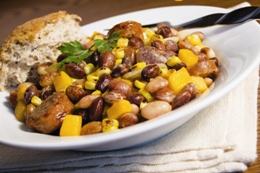Adding Legumes to Your Curriculum
01 June 2009By Colin Roche, MBA, CEC, CCE, FMP, CHE, Johnson & Wales University
 These mini- and full-lab exercises will help you teach legumes effectively.
These mini- and full-lab exercises will help you teach legumes effectively.
Legumes (LEHG-yooms) are a group of plants that have double-seemed pods containing a single row of seeds. Examples include peas, beans, lentils, soybeans and peanuts. Cultures around the world have used legumes as a staple food for thousands of years. Legumes are nutritious, have a long shelf life, and contribute flavor and texture to a meal. As more and more customers today demand healthful foods with flavor, commercial kitchens are making legumes an important part of their menus.
Legumes come in many different sizes, shapes and colors. There are dozens of types of legumes, each with a different texture and flavor.
Nutrition
Nutritionally, legumes contain little fat and no cholesterol and are an excellent source of complex carbohydrates, protein and soluble fiber. They provide iron, potassium, folate and other B vitamins, calcium and zinc, and are an essential protein source for people who follow a vegetarian diet. Legumes consist of 20% to 25% proteins, which is double that found in wheat and three times that found in rice, and are sometimes called the “poor man’s meat.” In addition, researchers have found that beans have more disease-fighting antioxidants than almost all other fruits and vegetables.
Quality Characteristics
When selecting legumes, they should be brightly colored and uniformly sized, which ensure even cooking. Legumes should have smooth skin and should not look withered, which is a sign that they are old; nor should they be marked, shriveled, damaged or broken. Legumes keep drying as they age, so purchase only enough to last one month.
As with other dry goods, legumes should be stored in a cool, dark place with good ventilation. Keep open packages of legumes in airtight, moisture-proof containers. You should never store dry legumes in the refrigerator or in a humid area, as they will begin to absorb moisture immediately and will spoil. Legumes can be purchased in canned form, although the canning process destroys nutrients.
Cooking
Cooking legumes involves rehydration, the process of adding water back into the legume. Since the beans have been dried, they need to be filled with water again. This is usually accomplished in two steps, soaking and then simmering. Carefully sort through the legumes to remove any that are shriveled or discolored. You would also want to check for foreign objects such as pebbles or stems that might have slipped into the package. After sorting, legumes need to be rinsed in cold water repeatedly until the water is clear.
Many dried beans and legumes require soaking before cooking, so check the package to be sure. Soaking shortens the cooking time and makes the beans more digestible. In general, the longer legumes soak, the less time they will take to cook. Remove any legumes that float, as insects may have eaten the insides of the legume.
To soak, cover the washed beans with four times their volume of water and choose one of two soaking methods. 1) Normal soak: The traditional, healthier and most efficient way to soak beans. Put them in water and into the refrigerator for four to eight hours. Soaking beans under refrigeration prevents the beans from fermenting. 2) Quick soak: An alternative method is to bring the beans to boil for one minute, turn off the heat, cover and let sit for one hour.
Beans have been appropriately soaked once they are uniformly tender. After soaking legumes, you have two choices: Drain the soaking water, rinse the beans and then cook with fresh water, or, cook them in the water they were soaked in. The first choice will reduce flatulence, while the second provides more nutrients.
Whether reusing soaking water or adding fresh, there should be twice as much water as beans. Bring the legumes and cooking liquid to a boil uncovered, skim off any foam that collects on the surface, lower heat, cover and simmer until tender. Cooking times can range from 30 minutes to three hours. Test for doneness by tasting a few beans. When legumes are tender but not too soft, they are ready to be used for food preparation.
|
Lesson Objectives
|
|
|
|
|
Mini Lab
|
|
|
|
|
Full Lab
|
|
|
Step 1
Step 2
Step 3
Step 4
|
|
Colin Roche, MBA, CEC, CCE, FMP, CHE, is department chair and an assistant professor at the College of Culinary Arts at the North Miami campus of Johnson & Wales University. With more than two decades of experience in the hospitality field, in 2008 he was awarded postsecondary Educator of the Year by the Foodservice Educators Network International (FENI).
A member of The National Writers Association and the Florida Writers Association, Roche has been published in various food magazines and newspapers. He is the editor of the College of Culinary Arts newsletter and is an active member of several campus organizations. Roche is currently pursuing his doctoral degree at Florida Atlantic University.
